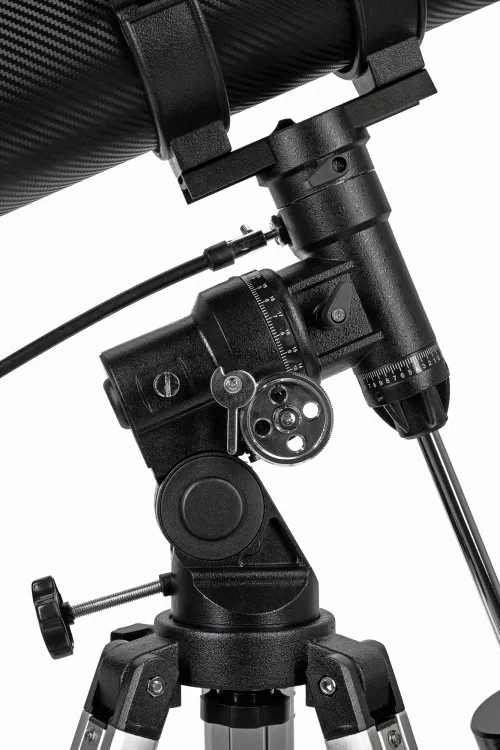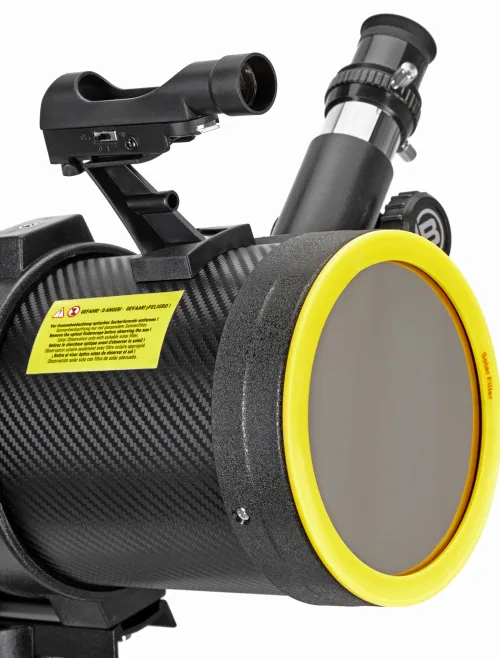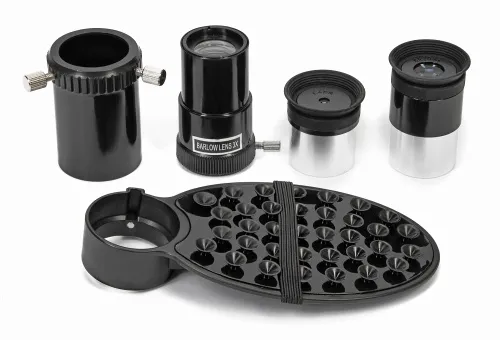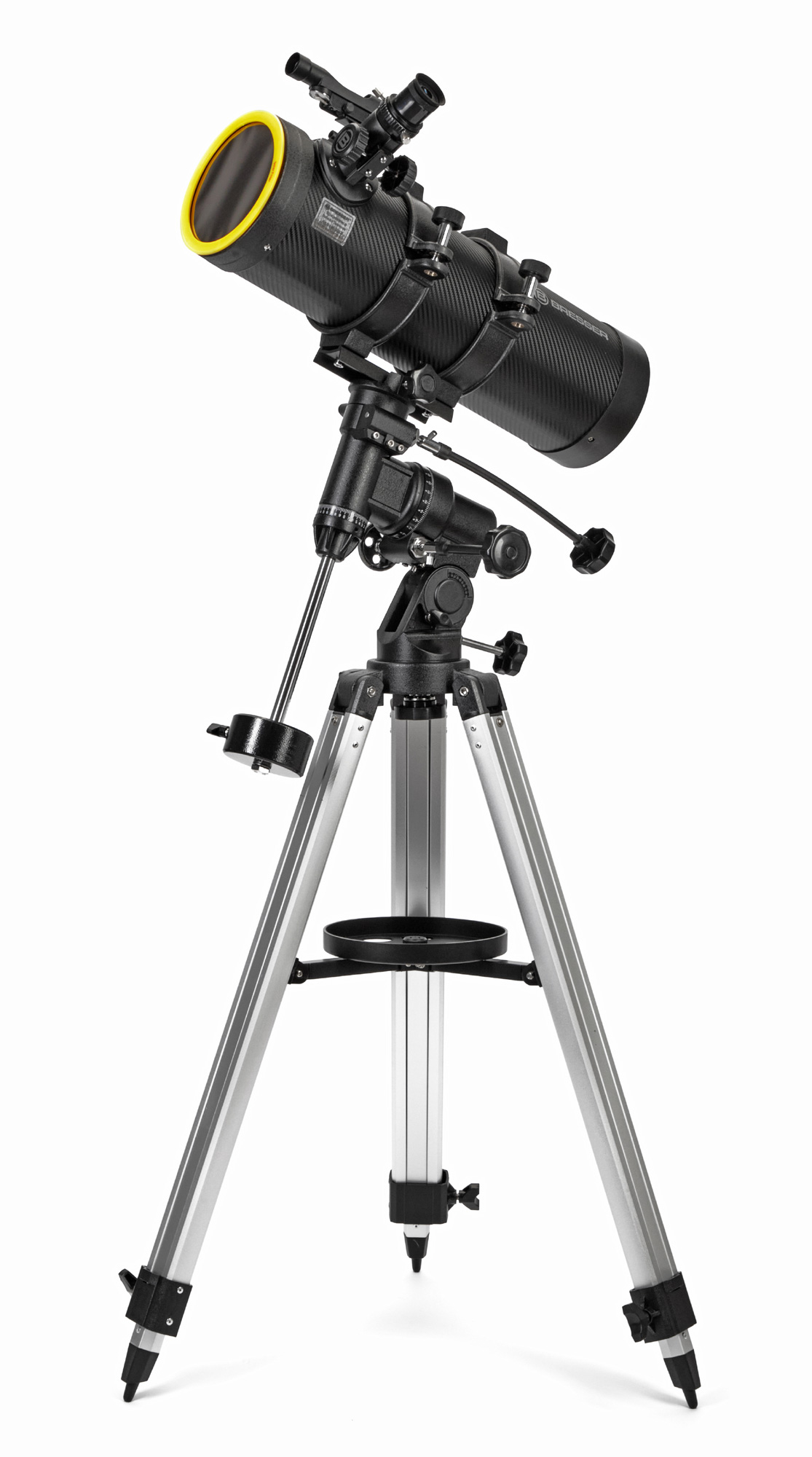Bresser Spica 130/1000 EQ3 Telescope with smartphone adapter
Newtonian telescope with solar filter. Primary mirror diameter (aperture): 130mm. Focal length: 1000mm
| Product ID | 74249 |
| Brand | Bresser GmbH, Germany |
| Warranty | 2 years |
| EAN | 4007922058825 |
| Package size (LxWxH) | 89x40x21 cm |
| Shipping Weight | 11.5 kg |
NEW - now including a high-quality aperture Solar-filter for safe observation of sunspots, eclipses and planet transits.
A great serious beginner's scope with reasonable aperture mirror and a long focal length which allows the observation of many celestial targets. Thanks to the catadioptic system (integrated Barlow lens) the length of the tube is kept to a minimum, which aids transportation and storage. The Bresser Spica comes on an equatorial mount with aluminium tripod, allowing accurate tracking of objects at high powers, using integrated gears and manual slow motion controls (the mount can also be motorised with the addition of a Right Ascension motor kit at a later date). All Newtonian Telescopes have a drawtube focuser on the side of their tube, this offers an adjustable viewing angle, which can be set to the user's liking by revolving the tube in the support rings - offering comfort while observing celestial bodies. Explore the planets within our solar system and discover the brighter deep sky objects.
With the included smartphone camera adapter you can take pictures of your observations right through the telescope's eyepiece.
Features:
- Telescope for night and solar observation
- Optical system: Newtonian
- Highest practical power: 260x
- Objective lens diameter: 130mm
- Focal length: 1000mm
- Aperture ratio: f/7.7
- Mounting: Equatorial EQ-3
- Eyepiece diameter: 31.7mm (1.25")
The kit includes:
- Telescope
- Aperture Solar-filter
- Eyepieces: 4mm, 20mm
- LED Viewfinder
- 3x Barlow lens (for use with 20mm eyepiece only)
- Smartphone camera adapter
- Aluminium tripod
- Accessory tray
- Software
| Product ID | 74249 |
| Brand | Bresser GmbH, Germany |
| Warranty | 2 years |
| EAN | 4007922058825 |
| Package size (LxWxH) | 89x40x21 cm |
| Shipping Weight | 11.5 kg |
| Optical design | reflector |
| Optical scheme | Newtonian |
| Primary mirror diameter (aperture), mm | 130 |
| Focal length, mm | 1000 |
| Aperture ratio | f/7.7 |
| Resolution threshold, arcseconds | 1.06 |
| Eyepieces | 4mm, 20mm |
| Eyepiece barrel diameter, in | 1.25 |
| Barlow lens | 3x |
| Finderscope | red dot, LED |
| Solar filter included | ✓ |
| Tripod | aluminum |
| Accessory tray | ✓ |
| Mount | equatorial, EQ3 |
| User level | beginners |
| Observed object | deep-sky objects, planets of the Solar System, the Sun |
Convenient diagrams that describe how to install additional accessories on refractors and catadioptric telescopes
Find out how to assemble a telescope on an example of the Levenhuk Skyline 90x900 EQ telescope
This short guide will help you avoid typical mistakes and learn more about telescope and mounting types
The basics of astronomical observations for beginners
In this article we have gathered answers to some of the most frequently asked questions about telescopes
How telescopes work?
You can actually perform observations from your balcony!
All about telescope sizes, types, magnification, and mounts
Learn how to set up and use the telescope properly
Astronomy in light-polluted skies. Find out what you can observe in the city
Read an interesting comprehensive article on telescopes for little astronomers
Celestial objects you can observe with telescopes of different apertures
Colored and vivid images of galaxies, planets and star clusters entrance everyone who is fascinated by boundless space
Find an interesting review on the history of the changes to a refracting telescope
To make the process of choosing a telescope easier, we will tell you about the characteristics of the most popular types of telescopes today
Learn everything you need to know about refractor telescopes to make the right choice



















